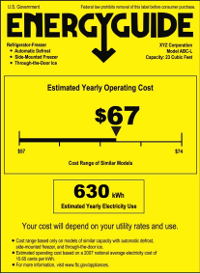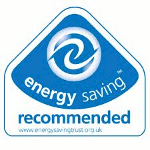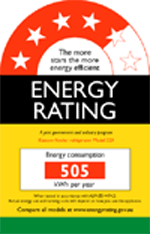Home appliances energy rating systems
Energy Star certified dryers consume, on average, 20% less energy than non-certified units, without sacrificing performance or useful features.
They involve energy saving features, such as moisture sensors (able to automatically shut the dryer off, when clothes are dry enough) or steam cycles (designed to help prevent wrinkles in your clothes). And they help reduce greenhouse gas emissions.
It's an example. Buying certified appliances is worthwhile. But be aware. Energy rating systems may have limitations.
Energy star and energyGuide Labels in America and Canada
 Energy Guide labels allow consumers to compare the energy consumption of household appliances, and can help select the most energy efficient units, and the best for the environment.
Energy Guide labels allow consumers to compare the energy consumption of household appliances, and can help select the most energy efficient units, and the best for the environment.
But these programs and the energy labels and standards that they use aren't necessarily as stringent as they should.
An US-Canada Energy qualified appliance exceeds by 10% (freezers) or 15% (refrigerators) or 20% (clothes dryers) or 30% (clothes washers) the federal minimum standards for energy efficiency. And that's a good starting point...
But is is far from being very good or excellent; some qualified appliances are only moderately efficient (or relatively inefficient, if you prefer). Criteria change, and there are cases where the standards fall short of the best (see entry below). They may not be comprehensive or stringent enough.
Note: in USA and Canada, take into account the Most Efficient logo from Energy Star. They allow to overcome part of the limitations mentioned earlier.
 Energy Star rating system & Yellow EnergyGuide labels limitations in America
Energy Star rating system & Yellow EnergyGuide labels limitations in America
The yellow EnergyGuide label and the Energy Star label aren’t necessarily a faithful indicator of energy efficiency.
How can that be possible?
Consider, for instance, the Energy Star program for refrigerators.
The program divides refrigerators into several categories - top-mount freezer, bottom-mount freezers, side-mount freezers… with or without door ice dispensers – and compares energy consumption only with models in the same category. And the same goes for the EnergyGuide labels.
And that’s not a good method; some of the categories (types) of refrigerators are extremely energy intensive. That’s the case of side-mounted refrigerator-freezers with through-the-door water and ice dispensers. The Energy Star label for this type of refrigerators is misleading. And the same goes for the yellow EnergyGuide labels. See, for details: Best Refrigerator and Freezer Types and Styles.
For further details on energy-efficiency rating labels for appliances and electronics, see:
Energy Star Most Efficient Canada
US Federal Trade Commission: Use the Energy Label Guide
Energy Star: How a Product Earns the Energy Star Label
 Energy-efficiency rating for appliances and electronics in Europe
Energy-efficiency rating for appliances and electronics in Europe
The energy-efficiency rating system in the UE includes the UE Energy Label, the UE Ecolabel (indicating that the appliance is among the most environmentally-friendly) and some national label-logos like the British Energy Saving Trust “Energy Saving Recommended”.
 The EU Energy label rates products from A (the most efficient) to G, and the energy consumption (in kilowatts-hour per year).
The EU Energy label rates products from A (the most efficient) to G, and the energy consumption (in kilowatts-hour per year).
The labels attached to some appliances may also include specific information (ratings for wash, spin and dry cycles, in the case of clothes washers; noise, capacity…). See, for more information: UE Labeling and Wikipedia UE Labels.
 Energy star rating for appliances in New Zealand and Australia
Energy star rating for appliances in New Zealand and Australia
The Australian and New Zealander energy rating system for appliances and electronics is based on stars (the more stars, the better) and energy consumption (typically kilowatt-hour-year).
See, for further details: Energy Rating Labeling Australia and New Zealand
![]() Related Content
Related Content
![]() Top .... Home Page
Top .... Home Page


